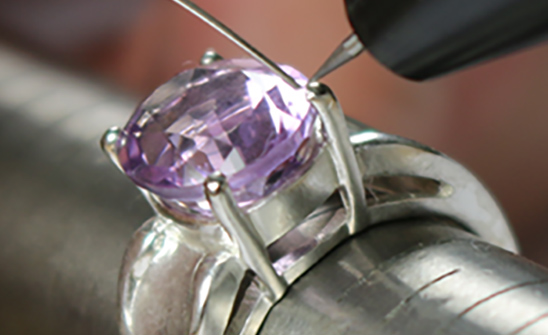We know that starting your jewellery making journey can be overwhelming which is why, as a part of our how to make jewellery hub we’re giving you some helpful advice, tips, guides and more on a range of jewellery making. Here we’ve put together a list of some popular stone setting tools that you’ll need in your essential kit.
Stone setting is an essential skill in the field of jewellery making. It involves securely placing gemstones onto metal settings, creating stunning pieces of wearable art. To achieve successful stone setting, several tools and techniques are required. This document will outline the necessary requirements for stone setting in jewellery.
1. Gemstones: The first requirement for stone setting is, of course, the gemstones themselves. These can be precious or semi-precious stones, such as diamonds, rubies, emeralds, sapphires, or any other desired stone. The size, shape, and cut of the gemstones will determine the type of setting needed.
2. Metal Settings: Metal settings are the structures that hold the gemstones in place. These settings are made from various metals, including gold, silver, platinum, or other alloys. The choice of metal depends on personal preference, budget, and the desired aesthetic of the jewellery piece.
3. Setting Tools: To set the stones securely, a jeweller requires a set of specialized tools. These tools include:
– Bezel Pusher: Used to push and secure gemstones in bezel settings.
– Prong Pusher: Designed to push and bend prongs over gemstones in prong settings.
– Burnisher: Used to smooth and polish the metal around the gemstone once it is set.
– Pliers: Essential for gripping and manipulating metal settings during the stone setting process.
– Files: Used to shape and refine metal settings for a perfect fit.
4. Workbench: A sturdy workbench is essential for stone setting. It provides a stable surface for the jeweller to work on and ensures precision and accuracy during the setting process. The workbench should have a comfortable height and be equipped with a vise to hold the jewellery piece securely.
5. Lighting: Proper lighting is crucial in stone setting to ensure accurate positioning and alignment of the gemstones. Adequate lighting helps the jeweller to see the details and make precise adjustments. Natural daylight or specialized jewellery lighting is recommended for the best results.
6. Safety Equipment: Stone setting involves working with small, sharp tools and delicate materials. Therefore, safety equipment is necessary to protect the jeweller’s hands and eyes. Safety glasses, finger guards, and gloves should be worn to minimize the risk of injury.
7. Expertise and Skill: Stone setting is a specialized technique that requires expertise and skill. Knowledge of different setting techniques, such as prong setting, bezel setting, or channel setting, is essential. With practice and experience, a jeweller can master the art of stone setting and make beautiful jewellery pieces.
In conclusion, stone setting in jewellery requires a combination of the right materials, tools, and skills. By having the necessary gemstones, metal settings, setting tools, a proper workbench, appropriate lighting, safety equipment, and expertise, a jeweller can achieve stunning stone settings and make exquisite pieces of jewellery. Don’t forget to visit the stone setting page of our how to make jewellery hub for some useful guides and project inspiration.

Cooksongold

